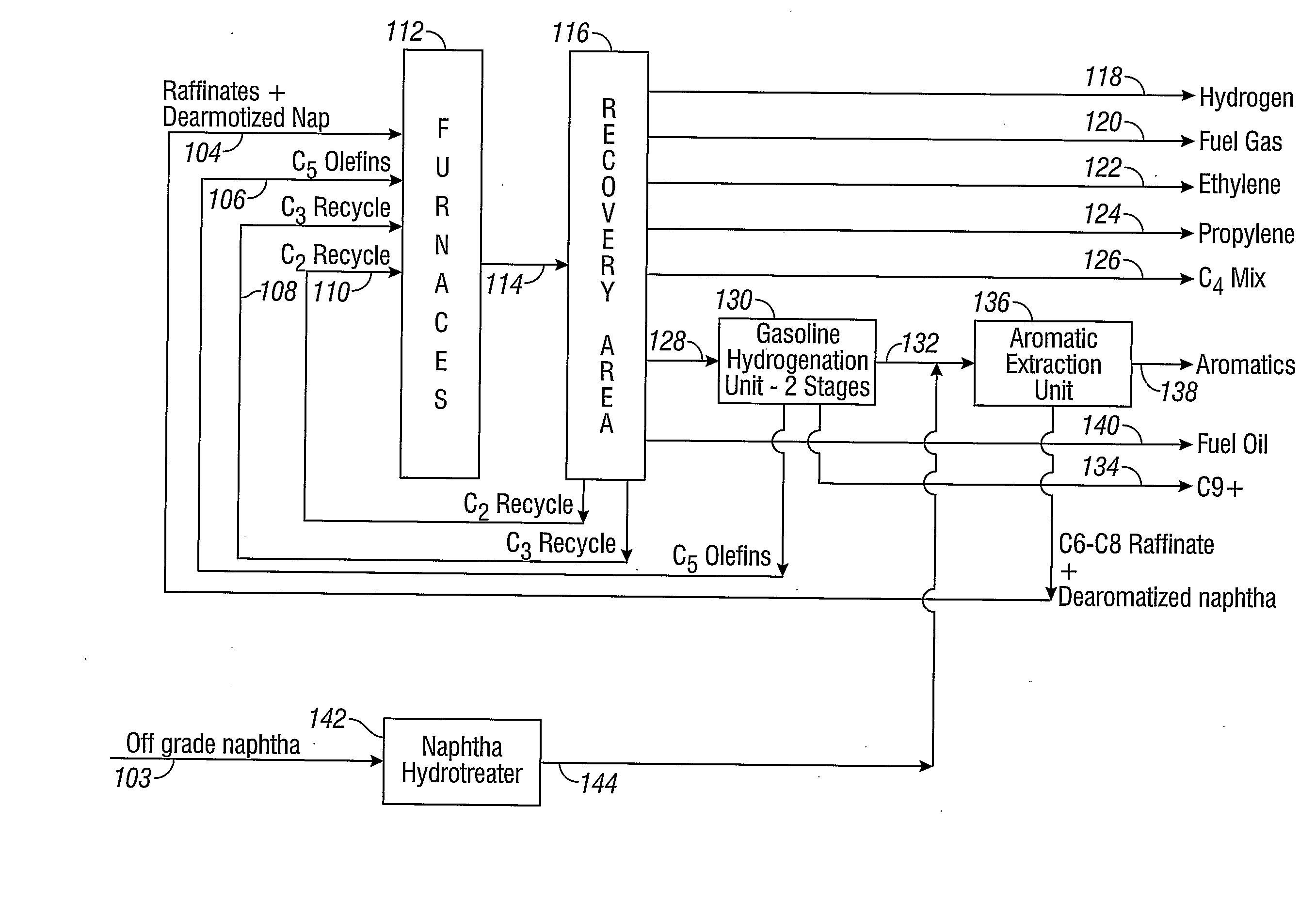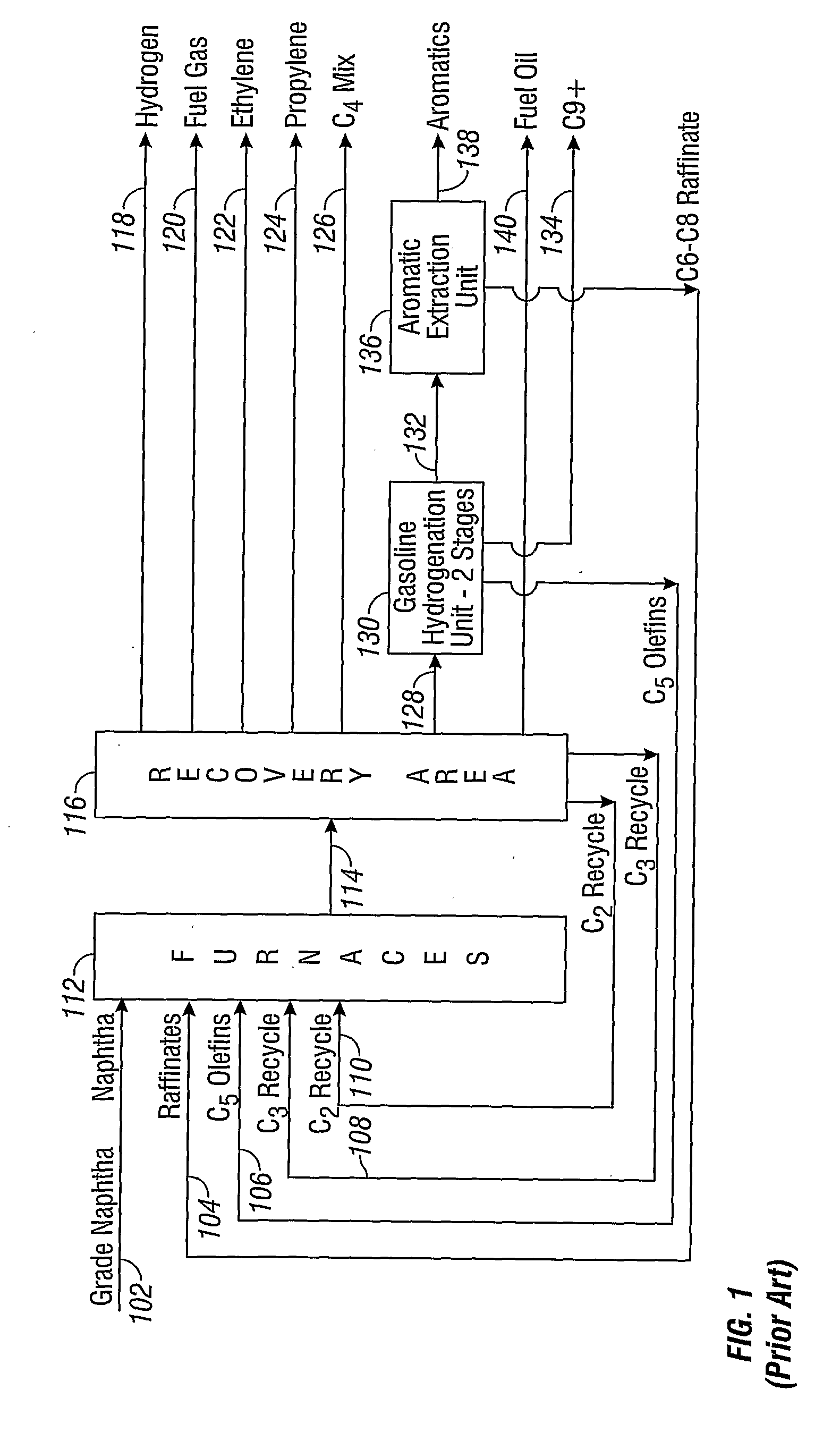Steam Cracking with Naphtha Dearomatization
a naphtha dearomatization and steam cracking technology, applied in the direction of thermal non-catalytic cracking, organic chemistry, chemistry apparatus and processes, etc., can solve the problems of unscheduled shutdown of steam crackers, aromatic compounds typically producing undesirable fuel oil, and less suitable feedstock for ethylene production without upgrading
- Summary
- Abstract
- Description
- Claims
- Application Information
AI Technical Summary
Benefits of technology
Problems solved by technology
Method used
Image
Examples
example 1
[0053]In this example OSN based ethylene plant performance with OSN naphtha is compared to steam cracker performance with the naphtha A feed. The comparison shows that naphtha A is not well suited for processing in the OSN based steam cracker. Yields were calculated using the Pycos model. The naphtha A feed steam cracker performance is modeled to first calculate overall material balance, and then total furnace effluents are calculated to determine the size requirements for ethylene plant equipment. Comparisons of overall material balance, the major area sizes and fouling compounds in the quench oil tower feed of an OSN ethylene plant versus Naphtha A based ethylene plant are presented in Table 2.
TABLE 2Steam Cracker ComparisonsCase12OSNNaphthaNaphthanaphthaAPropylene / Ethylene ratio0.50.5Overall Material BalanceFeedskTAkTAJOS naphtha2,455.6—Naphtha A or B—2,850.5Total2,455.62,850.5ProductsHydrogen15.613.2FG389.7367.4Ethylene800.0800.0Propylene400.0400.0Butadiene127.1120.1Raffinate-11...
example 2
[0055]An OSN feed ethylene plant is compared to a dearomatized naphtha A feed ethylene plantusing the similar calculations as used in Example 1. Table 3 shows comparisons of the overall material balance, the major equipment sizes, and fouling compounds in the quench oil tower feed for selected compounds in the furnace effluents.
[0056]As shown in Table 3, a dearomatized naphtha A feed, having had aromatics removed, produces approximately 65% of the fuel oil produced from an OSN naphtha feed. Similarly, the fuel oil stripper no longer limits the ethylene capacity of the plant. The largest equipment size factor for dearomatized naphtha A feed ethylene plant is 1.03 for the ethylene compressor, which implies that the naphtha feed plant will produce approximately 97% of the ethylene capacity of an OSN naphtha feed ethylene plant.
TABLE 3Steam Cracker ComparisonsCase13NaphthaOSNNaphthanaphthaA with DAPropylene / Ethylene ratio0.50.5Overall Material BalanceFeedskTAkTAJOS naphtha2,455.6—Naphth...
example 3
[0059]In this example an OSN based steam cracker feed is compared to a naphtha B based steam cracker feed showing the performance and unsuitablity of naphtha B as a feed in an OSN based steam cracker. Yields for naphtha B feed and the recycle streams were calculated using the Pycos model. The naphtha B steam cracker is modeled to calculate overall material balance, and total furnace effluents, which are used to determine the size of major equipment for the ethylene plant. Table 4 shows a comparison of the overall material balance, the major equipment sizes, and fouling compounds in the quench oil tower feed for an OSN feed ethylene plant versus naphtha B feed based ethylene plant.
[0060]Table 4 shows that naphtha B, being paraffin poor and aromatics rich, produces more than twice the amount of fuel oil as compared with an OSN feed. The area size factor for the fuel oil stripper is 2.2, which implies that an OSN ethylene plant with a naphtha B feed will produce at 46% of the ethylene ...
PUM
| Property | Measurement | Unit |
|---|---|---|
| weight ratio | aaaaa | aaaaa |
| weight percent | aaaaa | aaaaa |
| weight percent | aaaaa | aaaaa |
Abstract
Description
Claims
Application Information
 Login to View More
Login to View More - R&D
- Intellectual Property
- Life Sciences
- Materials
- Tech Scout
- Unparalleled Data Quality
- Higher Quality Content
- 60% Fewer Hallucinations
Browse by: Latest US Patents, China's latest patents, Technical Efficacy Thesaurus, Application Domain, Technology Topic, Popular Technical Reports.
© 2025 PatSnap. All rights reserved.Legal|Privacy policy|Modern Slavery Act Transparency Statement|Sitemap|About US| Contact US: help@patsnap.com



